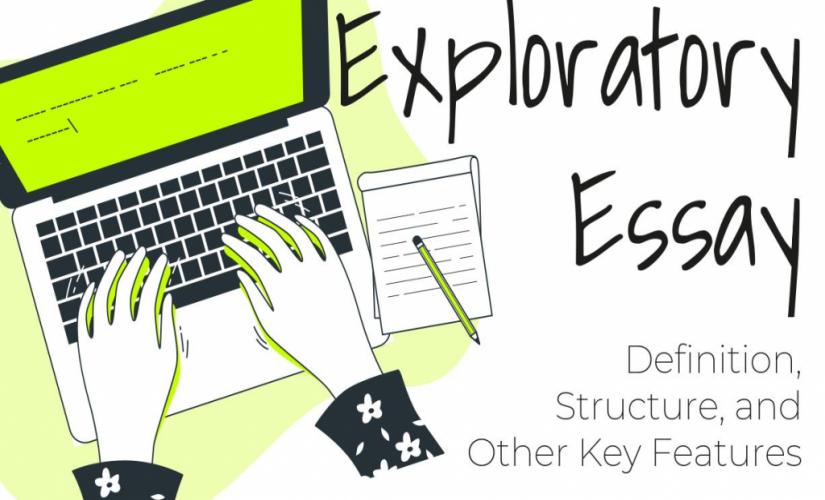This article discusses an exploratory essay type by looking into its key format features. Basically, people need to learn what is an exploratory essay to write papers correctly. For instance, understanding how to write a critique can enhance their writing techniques. As such, presented guidelines define exploratory writing and key important aspects to learn. Further on, topics and examples provide specific themes and completed papers, while basic steps on how to write an exploratory essay provide recommendations to follow. Moreover, a unique structure of such a paper includes an introduction, body, and conclusion. Finally, people can include different elements in their papers, but they need to keep in mind mistakes they should avoid.
What Is an Exploratory Essay and Its Purpose
According to its definition, an exploratory essay is a type and form of writing that investigates a topic by examining different perspectives and ideas without arguing for a specific position, aiming to understand and present some complexities of a chosen subject. Basically, unlike argumentative or persuasive papers, where an author takes a clear stance, an exploratory essay is more about a process of exploration and understanding (Hatch, 2022). Similarly, critical response essay example demonstrate an analytical approach to writing. In writing, people begin with a specific question or a problem, explore a unique theme from multiple angles, and discover new insights and ideas in an entire paper. For example, the main purpose of writing an exploratory research essay is to investigate a chosen topic thoroughly, to consider all possible viewpoints, and to present the findings in a balanced and unbiased manner (Strang, 1995). As such, this type of composition encourages critical thinking and allows a person to engage with different perspectives, making it particularly useful for complex or controversial topics where there may not be a clear-cut answer. Through this process, these papers often lead to a more informed and thoughtful discussion, resembling parts of expository essay analysis, highlighting a unique complexity of an issue at hand (Jones, 2024). In terms of pages and words, the length of an exploratory essay depends on academic levels, specific instructions, and class or instructor’s requirements, while general writing guidelines are:
High School
- Length: 1-3 pages
- Word Count: 250-750 words
College (Undergraduate)
- Length: 2-4 pages
- Word Count: 500-1,000 words
University (Advanced Undergraduate)
- Length: 3-5 pages
- Word Count: 750-1,250 words
Master’s
- Length: 4-8 pages
- Word Count: 1,000-2,000 words
Ph.D.
- Length: 6-12+ pages
- Word Count: 1,500-3,000+ words

Format
| Section | Content | Details |
|---|---|---|
| Title | A unique and concise title that reflects an exploratory essay’s topic or question. | Should give a reader an idea of a chosen subject being explored. |
| Introduction | Introduction to an assigned topic or problem. | Includes a brief overview of a topic, highlighting why it is significant. |
| Presentation of a central question or issue to be explored. | Poses a question or problem that guides an entire exploration. | |
| Explanation of an actual importance of exploring this issue from multiple perspectives. | Clarifies why a topic is complex and requires exploration. | |
| Body Paragraphs | Exploration of various perspectives on a particular topic. | Each paragraph should examine a different viewpoint or aspect of a central issue. |
| Presentation of evidence or examples supporting each perspective. | Uses research, examples, and evidence to support an entire discussion of each viewpoint. | |
| Discussion of some strengths and weaknesses of each perspective. | Analyzes how each perspective contributes to understanding a chosen issue, noting any limitations. | |
| Transition between perspectives, showing how each connects to or contrasts with others. | Ensures smooth transitions to maintain a good flow of a paper. | |
| Conclusion | Summary of key insights gained from exploring different perspectives. | Recaps main points discussed, emphasizing what was learned through exploration. |
| Reflection on some implications of the findings. | Discuss a broader significance of the findings and any new questions or ideas that emerged. | |
| Suggestion for further exploration or research if applicable. | Indicates areas that could benefit from further inquiry. | |
| List of References | List of all sources cited in an exploratory essay. | Follow a required citation style (e.g., APA, MLA, Chicago/Turabian, Harvard, etc.) and include all references used. |
Note: Some sections of an exploratory essay can be added, deleted, or combined with each other, depending on assignment requirements or instructor’s guidelines. For example, a standard exploratory essay format involves an introduction that presents a chosen topic and guiding question, body paragraphs that explore various perspectives with evidence, and a conclusion that summarizes critical insights without advocating a single viewpoint (Jones, 2024). Basically, exploratory writing is a process of investigating a specific topic by examining different perspectives and ideas, often without a predetermined conclusion, to gain a deeper understanding of a chosen subject. Further on, the key features of an exploratory essay include a neutral tone, an open-ended central question, an exploration of multiple perspectives, evidence-based analysis, and a conclusion that reflects on crucial insights gained without advocating a specific viewpoint (Arteaga, 2022). Exploratory writing examples include journal entries that reflect on a unique topic from different angles, research papers that investigate multiple viewpoints on an issue, and essays that explore a complex question without advocating a single conclusion. Moreover, the key difference between an expository essay and an exploratory essay is that the former explains and provides information on a specific theme with a clear thesis, while the latter investigates a chosen topic by examining multiple perspectives without taking a definitive stance (Hatch, 2022). In writing, an exploratory essay does not have a traditional thesis statement, but such a paper begins with a central question or problem and explores multiple perspectives without arguing for a specific position. On the other hand, the principal difference between a descriptive essay and an exploratory essay is that the former essay focuses on detailing and vividly describing a subject, while the latter examines different sides of an issue without committing to a specific viewpoint (Strang, 1995). Finally, to start an exploratory essay, people introduce a unique topic by providing background information and presenting an open-ended question or issue that invites multiple perspectives.
Topics and Examples
- How Does Animal Behavior Inform Human Psychology?
- Exploring the Future of Renewable Energy Sources
- Facebook’s Data Privacy Controversy: A Deep Dive
- Exploring the Essence of Success: A Philosophical Approach
- How Does Social Media Influence Mental Health Across Different Age Groups?
- Advancements in Technology and Their Impact on Privacy and Data Security
- In What Ways Does Climate Change Affect Global Food Security?
- Long-Term Effects of Digital Learning on Student Engagement and Academic Performance
- How Does a Current Rise of Remote Work Impact Workplace Culture and Productivity?
- Comparative Analysis of Educational Systems and Their Influence on Student Success
- How Do Cultural Differences Shape Approaches to Mental Health Treatment?
- An Influence of Government Policies on Healthcare Accessibility and Affordability
- What Are Some Social and Economic Consequences of Increasing Automation in a Workforce Setting?
- A Rise of Populism in Contemporary Politics and Its Underlying Causes
Steps on How to Write an Exploratory Essay
To write an exploratory essay, people explore chosen topics by examining multiple perspectives, supporting each with research, analyzing their strengths and weaknesses, and reflecting on key insights gained without taking a definitive stance. For example, an exploratory essay looks like a piece of writing that begins with an open-ended question, explores various perspectives with supporting evidence, and concludes with a reflection on some insights gained without taking a definitive stance (Mitchell et al., 2019). In writing, people use a first-person perspective in an exploratory essay, especially when reflecting on their own thought processes or experiences as they explore different perspectives. Hence, some crucial steps include:
- Choose a Topic: Select a complex topic for writing your exploratory essay that can be examined from multiple viewpoints.
- Conduct Preliminary Research: Gather diverse sources to understand different perspectives on a chosen theme.
- Formulate a Central Question: Develop an open-ended question that will guide your exploration and writing.
- Plan Your Structure: Organize your paper to logically examine different perspectives in a coherent sequence.
- Write an Introduction: Introduce an assigned topic and central question, explaining its significance and purpose.
- Present Different Perspectives in a Body: Explore various viewpoints in separate paragraphs, using evidence from your research.
- Analyze Each Perspective: Critically evaluate some of the strengths and weaknesses of each perspective discussed.
- Make Transitions Between Perspectives: Ensure smooth writing transitions to maintain a logical flow between different viewpoints.
- Write a Conclusion: Summarize key insights gained and reflect on an overall exploration without drawing definitive conclusions.
- Revise and Edit: Review your exploratory essay for clarity, coherence, and correctness, making necessary writing improvements.
Structure
In essence, an exploratory essay, like a research paper, is an author’s retrospective of writing and thinking processes as a person investigates a theme. For example, this type of paper describes when, how, and why a person undertook certain kinds of research work (Mitchell et al., 2019). As such, introspection and reflection on one’s thinking process are essential activities in exploratory writing. Finally, this type of composition flows just like most other types of papers, while key features are an introductory part, body paragraphs, and a concluding section.
Introduction
Concerning an introduction pargraph, a student outlines a specific phenomenon a person is investigating and a main objective of doing so. For example, an author offers a brief discussion about some of the causes of a chosen phenomenon, the people and institutions affected, and some possible solutions (Jones, 2024). Hence, a person also gives a brief overview of some of the researched sources that helped with an entire investigation. In turn, some examples of sentence starters for beginning an exploratory essay are:
- A topic of [topic] has sparked considerable debate and discussion due to its complexity and varying perspectives.
- In exploring a specific issue of [issue], it becomes evident that multiple viewpoints must be considered to fully understand its implications.
- A question of [question] presents a challenge, as it involves a range of perspectives that are not easily reconciled.
- As society grapples with [topic], it is essential to explore diverse viewpoints that shape people’s understanding of this issue.
- A complexity of [topic] lies in the fact that it can be approached from various angles, each offering unique insights.
- When considering a hot issue of [issue], one must take into account different aspects that contribute to an ongoing discussion.
- Exploring a debatable topic of [topic] requires an examination of multiple viewpoints that influence people’s perception of this issue.
- A debate surrounding [topic] highlights a real need to explore various directions that inform people’s overall understanding.
- Understanding [topic] involves covering different perspectives that offer a more comprehensive view of a current issue.
- A controversial issue of [issue] is not straightforward, and exploring various factors involved reveals its true complexity.
Thesis Statement
One of the essential elements in essay writing is a development of a thesis statement. Basically, a main claim becomes a foundation upon which a person builds an argument throughout a paper (Lee et al., 2015). However, in an exploratory essay, an author’s mission is to investigate a phenomenon, explain why it exists, and draw some preliminary conclusions on how it might be solved.
Body
In body paragraphs of an exploratory essay, people discuss an investigation process they followed in researching a chosen phenomenon – its causes and the people or institutions affected. For example, the information in these body paragraphs should include an introduction of a specific source, such as a title and an author, and why it is vital in an entire inquiry (Hatch, 2022). Further on, such a paragraph should include essential information a person found helpful to a discussed inquiry. In writing, an entire text should indicate a real importance and validity of the information to this inquiry. Lastly, a particular content should cover a brief personal introspection on how a presented source was helpful, such as giving a person a new perspective on a phenomenon under analysis.
Conclusion
A conclusion paragraph is a last part of an exploratory essay where people restate a phenomenon they investigated. For example, an author outlines some of the possible causes, reviews an intended audience or others affected, and highlights some possible solutions (Strang, 1995). Further on, people discuss some lingering questions that remain after investigating a phenomenon under examination. Basically, they explain why they think these questions are essential. In writing their concluding remarks, people indicate a logical need for further research work to find answers to those questions.
Difference
The main writing difference between an exploratory essay and other types of compositions is that the former does not try to convince a reader of a validity of a thesis. Instead, such a paper delves into a discussion about a phenomenon. For example, standard body paragraphs of an argumentative composition exist to strengthen or confirm a thesis claim (Hatch, 2022). In contrast, such papers explain potentail causes and impacts of a phenomenon.
What to Include
| Element | Description |
|---|---|
| Topic Overview | A brief introduction to a specific issue or topic, explaining its significance and why it warrants exploration. |
| Central Question | An open-ended question that guides an exploration of a chosen topic, helping to frame a paper’s direction. |
| Multiple Perspectives | Presentation of various viewpoints or approaches to a topic, showing different ways of understanding it. |
| Evidence and Examples | Supporting data, facts, or real-world examples that illustrate and back up each direction being explored. |
| Background Information | Context or history relevant to an assigned topic, helping readers to understand why an issue exists or is important. |
| Critical Analysis | An examination of some strengths, weaknesses, and implications of each side discussed. |
| Personal Reflection | Author’s reflections on how their understanding of the topic evolved as they explored different viewpoints. |
| Implications | Discussion of broader implications of an exploration for society, culture, or a specific field of study. |
| Unanswered Questions | New questions or areas for further exploration that arise from examining a chosen topic in depth. |
| Neutral Tone | A balanced, objective approach that avoids bias or advocating for one side over another. |
Common Mistakes
- Choosing a Narrow Topic: Selecting a topic that is too limited for writing can restrict a whole exploration of diverse perspectives.
- Taking a Strong Stance: Arguing for a specific viewpoint instead of exploring multiple angles undermines an exploratory nature of an entire paper.
- Lack of Research: Failing to conduct thorough research can result in a superficial examination of an assigned topic.
- Ignoring Multiple Perspectives: Overlooking or dismissing alternative viewpoints reduces a specific depth and balance of a complete paper.
- Poor Structure: Disorganized or unclear writing structure can confuse readers and disrupt an overall flow of exploration.
- Weak Transitions: Inadequate transitions between perspectives can make an exploratory essay difficult to follow.
- Superficial Analysis: Merely summarizing critical aspects without critically analyzing them leads to a lack of insight.
- Overemphasizing a Conclusion: Drawing a definitive conclusion instead of reflecting on an exploration diminishes a paper’s writing purpose.
- Inconsistent Tone: Shifting between formal and informal tone can confuse readers and undermine a composition’s credibility.
- Neglecting Revision: Skipping a revision process often leaves writing errors in clarity, coherence, and grammar that could have been corrected.
Summing Up
Exploratory essays help to broaden insight about a problem, outlining the likely causes, impacts on a target audience, and possible solutions. Most types of essays involve a writer trying to convince an audience about a thesis. However, this type of paper investigates a matter and highlights some preliminary conclusions. In turn, people end an exploratory essay by summarizing crucial insights gained from exploring various perspectives, reflecting on their implications, and suggesting areas for further inquiry without drawing a definitive conclusion.
References
Arteaga, A. (2022). Exploratory essay writing. Phenomenology & Practice, 17(1), 190–200. https://doi.org/10.29173/pandpr29479
Hatch, A. (2022). Basic essay writing. Englist Co., Ltd.
Jones, A. (2024). Exploratory writing: Everyday magic for life and work. Practical Inspiration Publishing.
Lee, J., Son, J., & Settle, Q. (2015). Exploratory writing in student learning. International Journal of Fashion Design, Technology and Education, 9(1), 9–15. https://doi.org/10.1080/17543266.2015.1099167
Mitchell, K. M., McMillan, D. E., & Rabbani, R. (2019). An exploration of writing self-efficacy and writing self-regulatory behaviours in undergraduate writing. The Canadian Journal for the Scholarship of Teaching and Learning, 10(2), 1–23. https://doi.org/10.5206/cjsotl-rcacea.2019.2.8175
Strang, S. M. (1995). Writing exploratory essays. Mayfield Pub.


